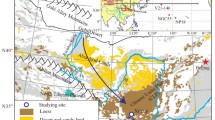Abstract
Major and trace elements as well as strontium isotopic composition have been analyzed on the acid-insoluble (AI) phase of the loess-paleosol sequence from Luochuan, Shaanxi Province, China. Results show that the chemical composition of AI phase of loess and paleosols is distinctive to the average composition of upper continental crust (UCC), characterized by depletion of mobile elements Na, Ca and Sr. The distribution pattern of elements in AI phase reveals that initial dust, derived from a vast area of Asian inland, has suffered from Na- and Ca-removed chemical weathering compared to UCC. Some geochemical parameters (such as CIA values, Na/K, Rb/Sr and87Sr/86Sr ratios) display a regular variation and evolution, reflecting that the chemical weathering in the source region of loess deposits has decreased gradually since 2.5 Ma with the general increase of global ice volume. This coincidence reflects that the aridity of Asian inland since the Quaternary is a possible regional response to the global climate change.
Similar content being viewed by others
References
Zhang, X., Zhang, G., Zhu, G. et al., Elemental tracers for Chinese source dust, Science in China, Ser. D, 1996, 39(5): 512–521.
Taylor, S. R., McLennan, S. M., McCulloch, M. T., Geochemistry of loess, continental crustal composition and crustal model ages, Geochimica et Cosmochimica Acta, 1983, 47: 1897–1905.
Wen, Q., Diao, G., Pan, J. et al., Comparison of average chemical composition of loess in Loess Plateau with Clark values of crust, Acta Pedologica Sinica (in Chinese), 1996, 33(3): 225–231.
Chen, J., Ji, J., Qiu, G. et al., Geochemical studies on the intensity of chemical weathering in Luochuan loess sequence, China, Science in China, Ser. D, 1998, 41(3): 235–241.
Gu, Z. Y., Liu, T. S., Guo, Z. T. et al., Weathering histories of Chinese loess deposits based on uranium and thorium series nuclides and cosmogenic10Be, Geochimica et Cosmochimica Acta, 1997, 61: 5221–5231.
Han, J., Fyfe, W. S., Longstaffe, F. T., Climatic implications of the S5 paleosol complex on the Southernmost Chinese Loess Plateau, Quaternary Research, 1998, 50: 21–33.
Chen, J., Wan, H. T., Lu, H. Y., Behaviours of REE and other trace elements during pedological weathering—Evidence from chemical leaching of loess and paleosol from the Luochuan sections in central China, Acta Geologica Sinica, 1996, 9: 290–302.
Quade, J., Chivas, A. R., McCulloch, M. T., Strontium and carbon isotope tracer and origins of soil carbonate in South Australia and Victoria, Palaeogeography Palaeoclimatology Palaeoecology, 1995, 113: 103–117.
Taylor, S. R., McLennan, S. M., The Continental Crust: Its Composition and Evolution, London: Blackwell, 1985, 277.
Nesbitt, H. W., Young, G. M., Prediction of some weathering trends of plutonic and volcanic rocks based on thermodynamic and kinetic considerations, Geochimica et Cosmochimica Acta, 1984, 48: 1523–1534.
Nesbitt, H. W., Markovics, G., Price, R. C., Chemical processes affecting alkalis and alkaline earths during continental weathering, Geochimica et Cosmochimica Acta, 1980, 44: 1659–1666.
Nesbitt, H. W., Young, G. M., Early Proterozoic climates and plate motions inferred from major element chemistry of lutites, Nature, 1982, 299: 715–717.
Dasch, E. J., Strontium isotopes in weathering profiles, deep-sea sediments, and sedimentary rocks, Geochimica et Cosmochimica Acta, 1969, 33: 1521–1552.
Liu, T., Zheng, M., Guo, Z., Initiation and evolution of the Asian monsoon system timely coupled with the ice-sheet growth and the tectonic movements in Asia, Quaternay Sciences (in Chinese), 1998, (3): 194–203.
Shackleton, N. J., Berger, A., Peltier, W. R., An alternative astronomical calibration of the low Pleistocene time scale based on ODP site 677, Royal Society of Edinburgh Transactions, 1990, 81: 251–261.
Kukla, G., Heller, F., Liu, X. M. et al., Pleistocene climates in China dated by magnetic susceptibility, Geology, 1988, 16: 811–814.
Gallet, S., Jahn, B. M., Lanoê, B. V. et al., Loess geochemistry and its implications for particle origin and composition of the upper continental crust, Earth and Planetary Science Letters, 1998, 156: 157–172.
Gu, Z., Ding, Z., Xiong, S. et al., A seven million geochemical record from Chinese red-clay and loess-paleosol sequence: weathering and erosion in northwestern China, Quaternary Sciences (in Chinese), 1999, (4): 357–365.
Author information
Authors and Affiliations
Corresponding author
Rights and permissions
About this article
Cite this article
Chen, J., An, Z., Liu, L. et al. Variations in chemical compositions of the eolian dust in Chinese Loess Plateau over the past 2.5 Ma and chemical weathering in the Asian inland. Sci. China Ser. D-Earth Sci. 44, 403–413 (2001). https://doi.org/10.1007/BF02909779
Received:
Issue Date:
DOI: https://doi.org/10.1007/BF02909779




